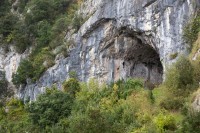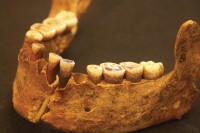 The El Mirón cave the Rio Asón valley of eastern Cantabria, Spain, has seen continuous human occupation from the Middle Paleolithic 41,000 years ago right through to the Bronze Age. The cave has been excavated yearly since the 1996 by a research team co-directed by Manuel González Morales of the International Prehistoric Research Institute of Cantabria and Lawrence Guy Straus, Professor of Anthropology at the University of New Mexico. In 2010, they discovered human bones deposited against the wall of a chamber at the back of the cave behind a limestone slab and encircled with the remains of small bonfires. The bones — an incomplete set including a mandible, a tibia with animal bites, several vertebrae and ribs, phalanges and part of the cranium — belonged to a woman between 35 and 40 years old at the time of death. The skeletal remains and the sediment on which they rest were covered in ochre which is why she was dubbed the Red Lady of El Mirón.
The El Mirón cave the Rio Asón valley of eastern Cantabria, Spain, has seen continuous human occupation from the Middle Paleolithic 41,000 years ago right through to the Bronze Age. The cave has been excavated yearly since the 1996 by a research team co-directed by Manuel González Morales of the International Prehistoric Research Institute of Cantabria and Lawrence Guy Straus, Professor of Anthropology at the University of New Mexico. In 2010, they discovered human bones deposited against the wall of a chamber at the back of the cave behind a limestone slab and encircled with the remains of small bonfires. The bones — an incomplete set including a mandible, a tibia with animal bites, several vertebrae and ribs, phalanges and part of the cranium — belonged to a woman between 35 and 40 years old at the time of death. The skeletal remains and the sediment on which they rest were covered in ochre which is why she was dubbed the Red Lady of El Mirón.
Radiocarbon dating found that the Red Lady died and was buried 18,700 years ago near the end of the last Ice Age at the dawn of the Magdalenian period. It is the only relatively intact Magdalenian burial ever discovered on the Iberian Peninsula. Intact burials from the period have been found in France (the country where the type site was found) and Germany and individual bones from the period have been found in Spain before, but they were scattered and not associated with a grave.
 Cave burials in this era were very rare. All signs point to the Red Lady having been someone of great importance to the Upper Paleolithic people who used the cave as their home and workspace. The red ochre, very high in sparkly specular hematite, appears to have been imported, and the grave was tended for a significant amount of time because the ochre was reapplied after the long bones and much of the cranium were removed. The bones could have been victim to the unknown canine-sized predator whose teeth marks were found on the tibia, or the removal of the big bones also could have been a deliberate act. Her people could have removed them for display or some other ritual purpose and then reapplied the ochre. The discovery of numerous small hand and foot bones in the 2013 season confirmed that the soft tissues decomposed in place rather than the body having been dismembered before it was skeletonized.
Cave burials in this era were very rare. All signs point to the Red Lady having been someone of great importance to the Upper Paleolithic people who used the cave as their home and workspace. The red ochre, very high in sparkly specular hematite, appears to have been imported, and the grave was tended for a significant amount of time because the ochre was reapplied after the long bones and much of the cranium were removed. The bones could have been victim to the unknown canine-sized predator whose teeth marks were found on the tibia, or the removal of the big bones also could have been a deliberate act. Her people could have removed them for display or some other ritual purpose and then reapplied the ochre. The discovery of numerous small hand and foot bones in the 2013 season confirmed that the soft tissues decomposed in place rather than the body having been dismembered before it was skeletonized.
The large limestone block two meters (6.6 feet) long and one meter (3.3 feet) wide had fallen from the roof of the cave and was engraved with symbols — multiple fine lines some of which form a V-shape that may represent the pubic triangle, often used in Paleolithic art as a symbol of the female. The block fell a few hundred years before the Red Lady was buried in the small space behind it. The engravings date to around the time of the burial, so it could be that the Red Lady’s mourners made a grave marker of sorts out of it, hence the possible female symbol.
With no obvious grave goods, researchers have been studying other items found at the burial site to see if they may have been associated with the grave. They discovered a baby tooth of a second person, thousands of stone fragments, bones of red deer, ibex, fish, antler points, bone needles and beads made from pierced shells and animal teeth. Stable isotope analysis of the Red Lady’s teeth found that her diet mainly (80%) consisted of meat from hoofed animals (likely the red deer and ibex whose bones were found) with fish making up most of the remaining 20% except for small amounts of starchy plants, seeds and mushrooms.
Researchers also collected pollen samples.
María-José Iriarte-Chiapusso and Alvaro Arrizabalaga at the University of the Basque Country in Spain have taken a different tack, focusing on the pollen found at the burial site. They found an unexpected preponderance of pollen from the Chenopod group, which includes plants like spinach (Journal of Archaeological Science, doi.org/2vc). Chenopod pollen is rare at archaeological sites from this period, and the high concentration found by the researchers doesn’t match the patterns at burial sites in areas where these plants were a food source, says Iriarte-Chiapusso.
It is possible that the plants were used medicinally at this time, but that would still fail to explain the high levels of pollen. “The extraordinary nature of the finds within the burial suggest that [the plants] had been deliberately sought out for some purpose related to the deceased,” says Arrizabalaga. This leads the team to believe that the woman’s people may have left a floral offering at the grave, probably of small, yellowish flowers.
“You can’t get away from the conclusion that this person, [out of] the hundreds and perhaps thousands of Magdalenians who once existed for several thousand years in Iberia, was given some kind of special treatment,” says Straus. “God only knows why.”
Researches will study her DNA next in the hope that it will lend insight into the repopulation of Europe after the Last Glacial Maximum (ca. 21,000 years ago). Scientists hypothesize that when the cold was at its worst, people fled to southern climes before spreading back up north when temperatures warmed up again. If the Red Lady’s DNA can be linked to later populations in Belgium, Germany and the UK, it will be evidence that the Magdalenians who took refuge in Iberia went on to repopulate northern Europe.